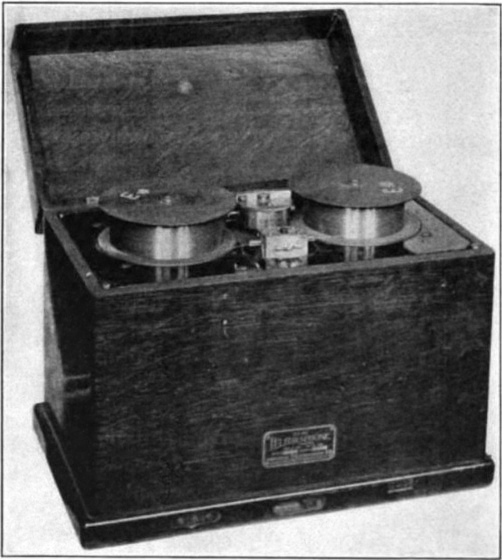Telegraphone_wire_recorder_1922.jpg
Summary
| Description Telegraphone wire recorder 1922.jpg |
English:
A
Telegraphone
steel
wire recorder
, the first audio
magnetic recording
technology, invented in 1898 by Danish-American engineer
Valdemar Poulsen
. Working similarly to a tape recorder, the fine steel wire unwinds from one reel, passes though a recording head, and is wound onto the other reel. In the head, the audio signal to be recorded passes through an electromagnet, creating a varying magnetic field. This creates a varying magnetization in the wire which is a record of the instantaneous sound amplitude. To play it back the wire is passed through a playback head where another electromagnet detects the varying magnetization and translates it back to a varying electrical signal, which is amplified and applied to a loudspeaker. Wire recorders had poor audio quality and were replaced by magnetic tape recording in the 1940s.
This example from 1922 was used by the RCA transatlantic telegraph operations center in New York to record incoming high speed Morse code radiotelegraph messages from Europe at 100 WPM, which were then replayed at lower speed to telegraph operators who translated it into text and typed it onto telegram forms to be sent to the recipient. |
| Date | |
| Source |
|
| Author | Julius Weinberger |
Licensing
| Public domain Public domain false false |
|
|
This media file is in the
public domain
in the
United States
. This applies to U.S. works where the copyright has expired, often because its first
publication
occurred prior to January 1, 1929, and if not then due to lack of notice or renewal. See
this page
for further explanation.
|
|
|
|
This image might not be in the public domain outside of the United States; this especially applies in the countries and areas that do not apply the
rule of the shorter term
for US works, such as Canada, Mainland China (not Hong Kong or Macao), Germany, Mexico, and Switzerland. The creator and year of publication are essential information and must be provided. See
Wikipedia:Public domain
and
Wikipedia:Copyrights
for more details.
|
Captions
Add a one-line explanation of what this file represents




